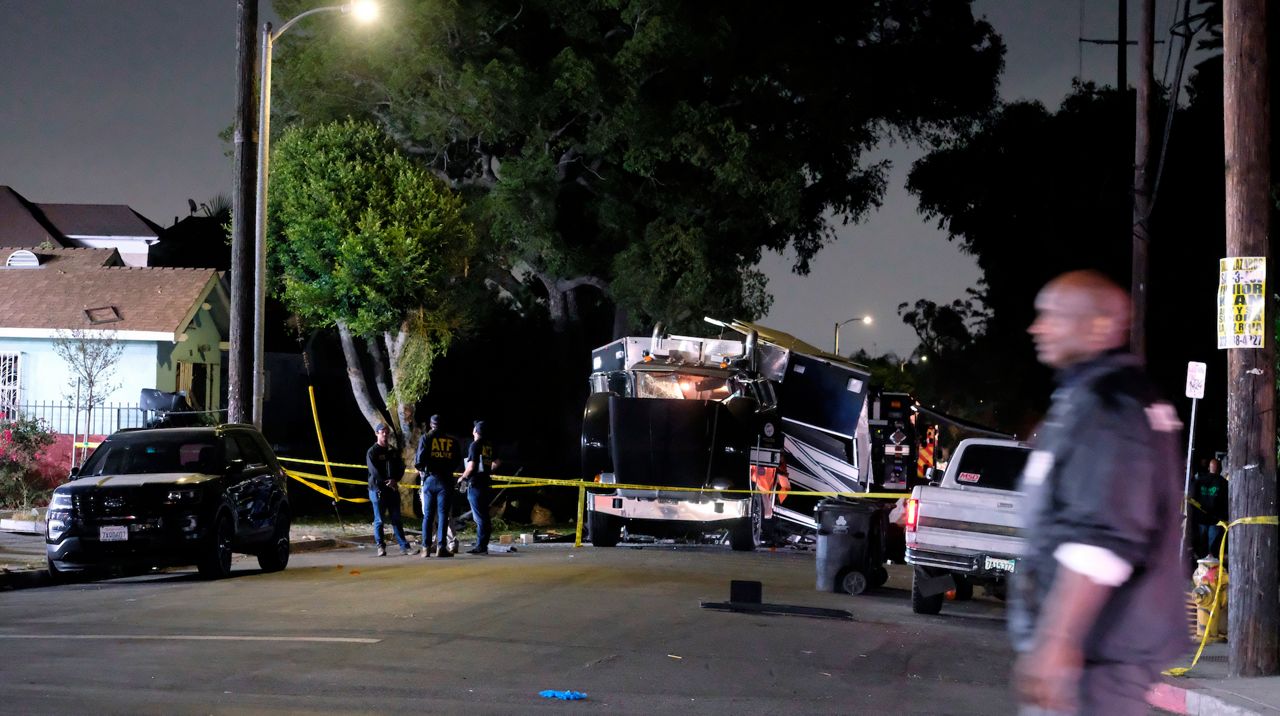LOS ANGELES (CNS) — Police Chief Michel Moore said Tuesday that 14 households were able to reoccupy their South Los Angeles homes following a destructive fireworks explosion set off on June 30 by an LAPD bomb squad, while the city has rented 29 long-term units for households awaiting structural repairs.
The detonation on East 27th Street, near San Pedro Street, sent 17 residents and first responders to hospitals, destroyed a bomb squad truck and damaged 22 residences, 13 businesses and 37 vehicles.
Moore told the Police Commission on Tuesday that all businesses around San Pedro Street have been able to reopen, along with full resumption of traffic on 27th Street. Displaced families were initially housed in local motels, but the city has now rented 29 "corporate housing" units, which Moore said were fit for long-term residency and include kitchens.
Sixteen residential structures remain unoccupied as repairs are pending, including an apartment complex that housed 14 families, Moore said. Families who live in the complex are technically allowed to return, but Moore said the building's owner was resisting because of "some legal issues over the repairs." Moore added that he wasn't clear on all the details.
A preliminary investigation into the blast by the Bureau of Alcohol, Tobacco and Firearms and Explosives' National Response Team found that the Los Angeles Police Department bomb squad significantly underestimated, based on a visual assessment, the weight of explosive material being loaded into the truck for detonation.
Councilman Curren Price announced a $1 million emergency fund last week using his office's Environmental Equity and Reimagining Public Safety dollars to provide long-term housing, repairs and financial assistance to residents whose homes were damaged by the blast.
"It should never have happened in the first place and it is clear that the city is at fault in this explosion. But the damage and destruction has been done, and it is now time to restore our families and rebuild our community," Price said.
The councilman said his fund will give displaced residents housing, help them with home repairs — including broken windows, plumbing and structural repairs — as well as provide $10,000 no-strings-attached grants to 25 households that have been pre-identified as being severely impacted. The nonprofit Mayor's Fund for Los Angeles also gave $2,000 in cash assistance to 26 households impacted by the explosion.
The truck — which had been used 41 previous times over the last decade, including for three detonations in June — can safely contain the detonation of up to 15 pounds of explosive materials for repeated use or up to 25 pounds for one-time use that would render the truck out-of-service in the future.
Bomb technicians followed department protocols to limit handling of the explosive devices and estimated the total amount of explosive material being loaded into the truck at 16 1/2 pounds, Moore said on July 19. The National Response Team's physical weighing of the materials found that the actual amount was 42 pounds.
Price said that he was "infuriated" by the findings that the bomb squad likely overloaded the truck with explosives. He called the error "by far, one of the LAPD's largest blunders in recent history, which has further betrayed the trust of our South L.A. community."
Moore insisted on July 19 that bomb squad technicians were "operating with the best intentions" in a stressful situation. But he said if mistakes were made in estimating the weight of explosive material placed in the truck, "I will hold the appropriate individuals accountable."
He said the bomb squad has already begun implementing new procedures as a result of the explosion, including the required presence of a commanding officer during future detonations. The department will seek best practices from other departments to evaluate what other changes should be made, according to Moore.
On July 19, the city opened a resource center to assist affected residents at the YMCA at 1006 E. 28th St. to serve as the designated location where victims can connect with a wide range of services, including opportunities to file a claim, obtain mental health and wellness referrals, as well as other supportive services. The office is open weekdays from 3 p.m. to 6 p.m.
The ATF's National Response Team responded to the scene on July 2 and conducted a weeklong investigation. It will formalize a "cause and origin report" based on its field work, 40 interviews with witnesses and personnel, forensic tests and evaluation of damage and surveillance footage. The report will be sent to the National Center for Explosive Training and Research for review, and the LAPD expects to have in the next few weeks.
Authorities have said about 32,000 pounds of fireworks were being stored at a home on East 27th Street, where they were being sold. The home's resident, Arturo Ceja III, 27, was charged with illegally transporting tons of explosives. He is set to be arraigned Aug. 2.
Prosecutors said Ceja purchased most of the explosives from a dealer in Pahrump, Nevada.



